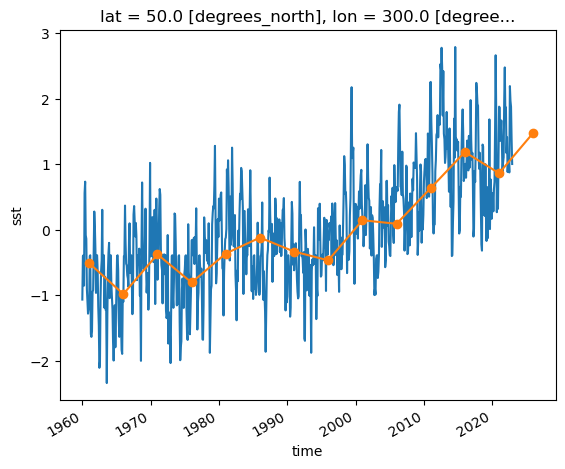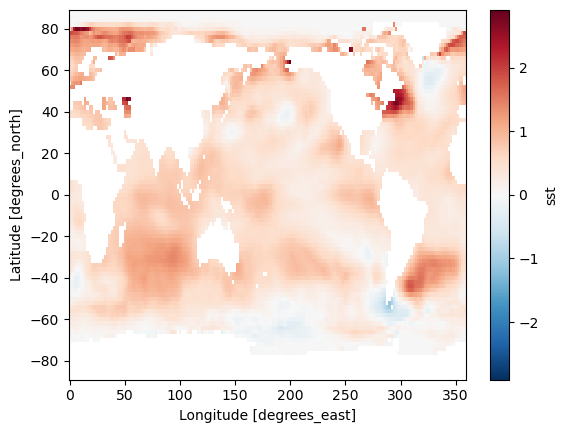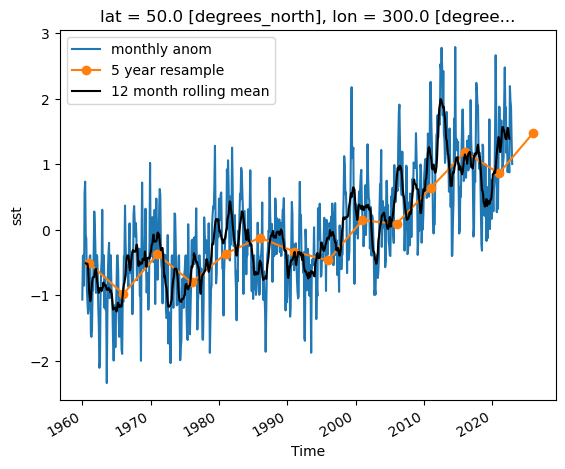21. Xarray Interpolation, Groupby, Resample, Rolling, and Coarsen#
Attribution: This notebook is a revision of the Xarray Interpolation, Groupby, Resample, Rolling, and Coarsen notebook by Ryan Abernathey from An Introduction to Earth and Environmental Data Science. Thanks to Aiyin Zhang for preparing this notebook.
In this lesson, we cover some more advanced aspects of xarray.
import numpy as np
import xarray as xr
from matplotlib import pyplot as plt
21.1. Interpolation#
In the previous lesson on Xarray, we learned how to select data based on its dimension coordinates and align data with dimension different coordinates. But what if we want to estimate the value of the data variables at different coordinates. This is where interpolation comes in.
# we write it out explicitly so we can see each point.
x_data = np.array([0, 1, 2, 3, 4, 5, 6, 7, 8, 9, 10])
f = xr.DataArray(x_data**2, dims=['x'], coords={'x': x_data})
f
<xarray.DataArray (x: 11)> array([ 0, 1, 4, 9, 16, 25, 36, 49, 64, 81, 100]) Coordinates: * x (x) int64 0 1 2 3 4 5 6 7 8 9 10
f.plot(marker='o')
[<matplotlib.lines.Line2D at 0x78266cdaeed0>]
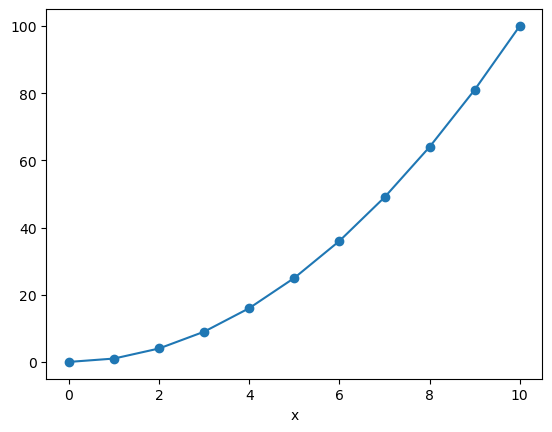
f.sel(x=3)
<xarray.DataArray ()>
array(9)
Coordinates:
x int64 3We only have data on the integer points in x. But what if we wanted to estimate the value at, say, 4.5?
f.sel(x=4.5)
---------------------------------------------------------------------------
KeyError Traceback (most recent call last)
File /srv/conda/envs/notebook/lib/python3.11/site-packages/pandas/core/indexes/base.py:3652, in Index.get_loc(self, key)
3651 try:
-> 3652 return self._engine.get_loc(casted_key)
3653 except KeyError as err:
File /srv/conda/envs/notebook/lib/python3.11/site-packages/pandas/_libs/index.pyx:147, in pandas._libs.index.IndexEngine.get_loc()
File /srv/conda/envs/notebook/lib/python3.11/site-packages/pandas/_libs/index.pyx:155, in pandas._libs.index.IndexEngine.get_loc()
File pandas/_libs/index_class_helper.pxi:70, in pandas._libs.index.Int64Engine._check_type()
KeyError: 4.5
The above exception was the direct cause of the following exception:
KeyError Traceback (most recent call last)
File /srv/conda/envs/notebook/lib/python3.11/site-packages/xarray/core/indexes.py:486, in PandasIndex.sel(self, labels, method, tolerance)
485 try:
--> 486 indexer = self.index.get_loc(label_value)
487 except KeyError as e:
File /srv/conda/envs/notebook/lib/python3.11/site-packages/pandas/core/indexes/base.py:3654, in Index.get_loc(self, key)
3653 except KeyError as err:
-> 3654 raise KeyError(key) from err
3655 except TypeError:
3656 # If we have a listlike key, _check_indexing_error will raise
3657 # InvalidIndexError. Otherwise we fall through and re-raise
3658 # the TypeError.
KeyError: 4.5
The above exception was the direct cause of the following exception:
KeyError Traceback (most recent call last)
Cell In[5], line 1
----> 1 f.sel(x=4.5)
File /srv/conda/envs/notebook/lib/python3.11/site-packages/xarray/core/dataarray.py:1549, in DataArray.sel(self, indexers, method, tolerance, drop, **indexers_kwargs)
1439 def sel(
1440 self: T_DataArray,
1441 indexers: Mapping[Any, Any] | None = None,
(...)
1445 **indexers_kwargs: Any,
1446 ) -> T_DataArray:
1447 """Return a new DataArray whose data is given by selecting index
1448 labels along the specified dimension(s).
1449
(...)
1547 Dimensions without coordinates: points
1548 """
-> 1549 ds = self._to_temp_dataset().sel(
1550 indexers=indexers,
1551 drop=drop,
1552 method=method,
1553 tolerance=tolerance,
1554 **indexers_kwargs,
1555 )
1556 return self._from_temp_dataset(ds)
File /srv/conda/envs/notebook/lib/python3.11/site-packages/xarray/core/dataset.py:2642, in Dataset.sel(self, indexers, method, tolerance, drop, **indexers_kwargs)
2581 """Returns a new dataset with each array indexed by tick labels
2582 along the specified dimension(s).
2583
(...)
2639 DataArray.sel
2640 """
2641 indexers = either_dict_or_kwargs(indexers, indexers_kwargs, "sel")
-> 2642 query_results = map_index_queries(
2643 self, indexers=indexers, method=method, tolerance=tolerance
2644 )
2646 if drop:
2647 no_scalar_variables = {}
File /srv/conda/envs/notebook/lib/python3.11/site-packages/xarray/core/indexing.py:190, in map_index_queries(obj, indexers, method, tolerance, **indexers_kwargs)
188 results.append(IndexSelResult(labels))
189 else:
--> 190 results.append(index.sel(labels, **options))
192 merged = merge_sel_results(results)
194 # drop dimension coordinates found in dimension indexers
195 # (also drop multi-index if any)
196 # (.sel() already ensures alignment)
File /srv/conda/envs/notebook/lib/python3.11/site-packages/xarray/core/indexes.py:488, in PandasIndex.sel(self, labels, method, tolerance)
486 indexer = self.index.get_loc(label_value)
487 except KeyError as e:
--> 488 raise KeyError(
489 f"not all values found in index {coord_name!r}. "
490 "Try setting the `method` keyword argument (example: method='nearest')."
491 ) from e
493 elif label_array.dtype.kind == "b":
494 indexer = label_array
KeyError: "not all values found in index 'x'. Try setting the `method` keyword argument (example: method='nearest')."
Interpolation to the rescue!
f.interp(x=4.5)
<xarray.DataArray ()>
array(20.5)
Coordinates:
x float64 4.5Interpolation uses scipy.interpolate under the hood. There are different modes of interpolation.
# default
f.interp(x=4.5, method='linear').values
array(20.5)
f.interp(x=4.5, method='nearest').values
array(16.)
f.interp(x=4.5, method='cubic').values
array(20.25)
We can interpolate to a whole new coordinate at once:
x_new = x_data + 0.5
f_interp_linear = f.interp(x=x_new, method='linear')
f_interp_cubic = f.interp(x=x_new, method='cubic')
f.plot(marker='o', label='original')
f_interp_linear.plot(marker='o', label='linear')
f_interp_cubic.plot(marker='o', label='cubic')
plt.legend()
<matplotlib.legend.Legend at 0x782661d96250>
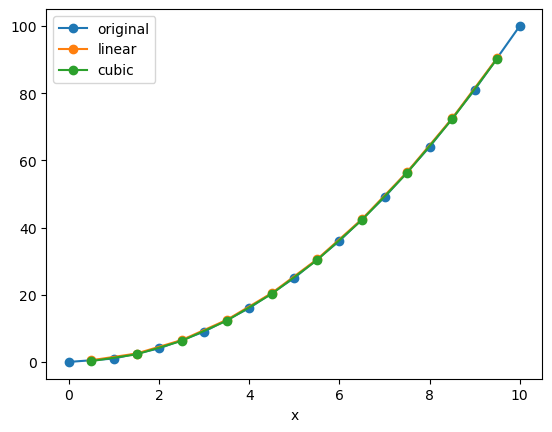
Note that values outside of the original range are not supported:
f_interp_cubic.values
array([ 0.25, 2.25, 6.25, 12.25, 20.25, 30.25, 42.25, 56.25, 72.25,
90.25, nan])
Note
You can apply interpolation to any dimension, and even to multiple dimensions at a time.
(Multidimensional interpolation only supports mode='nearest' and mode='linear'.)
But keep in mind that Xarray has no built-in understanding of geography.
If you use interp on lat / lon coordinates, it will just perform naive interpolation of the lat / lon values.
More sophisticated treatment of spherical geometry requires another package such as xesmf.
21.2. Groupby#
Xarray copies Pandas’ very useful groupby functionality, enabling the “split / apply / combine” workflow on xarray DataArrays and Datasets. In the first part of the lesson, we will learn to use groupby by analyzing sea-surface temperature data.
First we load a dataset. We will use the NOAA Extended Reconstructed Sea Surface Temperature (ERSST) v5 product, a widely used and trusted gridded compilation of historical data going back to 1854.
Since the data is provided via an OPeNDAP server, we can load it directly without downloading anything:
url = 'http://www.esrl.noaa.gov/psd/thredds/dodsC/Datasets/noaa.ersst.v5/sst.mnmean.nc'
ds = xr.open_dataset(url, drop_variables=['time_bnds'])
ds = ds.sel(time=slice('1960', '2022'))
ds
<xarray.Dataset>
Dimensions: (lat: 89, lon: 180, time: 756)
Coordinates:
* lat (lat) float32 88.0 86.0 84.0 82.0 80.0 ... -82.0 -84.0 -86.0 -88.0
* lon (lon) float32 0.0 2.0 4.0 6.0 8.0 ... 350.0 352.0 354.0 356.0 358.0
* time (time) datetime64[ns] 1960-01-01 1960-02-01 ... 2022-12-01
Data variables:
sst (time, lat, lon) float32 ...
Attributes: (12/39)
climatology: Climatology is based on 1971-2000 SST, X...
description: In situ data: ICOADS2.5 before 2007 and ...
keywords_vocabulary: NASA Global Change Master Directory (GCM...
keywords: Earth Science > Oceans > Ocean Temperatu...
instrument: Conventional thermometers
source_comment: SSTs were observed by conventional therm...
... ...
comment: SSTs were observed by conventional therm...
summary: ERSST.v5 is developed based on v4 after ...
dataset_title: NOAA Extended Reconstructed SST V5
_NCProperties: version=2,netcdf=4.6.3,hdf5=1.10.5
data_modified: 2023-11-03
DODS_EXTRA.Unlimited_Dimension: timeLet’s do some basic visualizations of the data, just to make sure it looks reasonable.
ds.sst[0].plot(vmin=-2, vmax=30)
<matplotlib.collections.QuadMesh at 0x782654dd3f50>
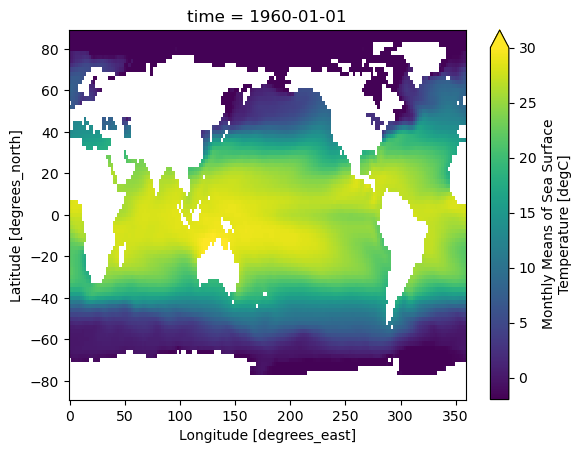
Other ways
ds.sst.sel(time = '1960-01-01').plot(vmin=-2, vmax=30)
<matplotlib.collections.QuadMesh at 0x78265439fa90>

ds.sst.isel(time = 0).plot(vmin=-2, vmax=30)
<matplotlib.collections.QuadMesh at 0x78265427b990>

Note that xarray correctly parsed the time index, resulting in a Pandas datetime index on the time dimension.
ds.time
<xarray.DataArray 'time' (time: 756)>
array(['1960-01-01T00:00:00.000000000', '1960-02-01T00:00:00.000000000',
'1960-03-01T00:00:00.000000000', ..., '2022-10-01T00:00:00.000000000',
'2022-11-01T00:00:00.000000000', '2022-12-01T00:00:00.000000000'],
dtype='datetime64[ns]')
Coordinates:
* time (time) datetime64[ns] 1960-01-01 1960-02-01 ... 2022-12-01
Attributes:
long_name: Time
delta_t: 0000-01-00 00:00:00
avg_period: 0000-01-00 00:00:00
prev_avg_period: 0000-00-07 00:00:00
standard_name: time
axis: T
actual_range: [19723. 81722.]
_ChunkSizes: 1ds.sst.sel(lon=300, lat=50).plot()
[<matplotlib.lines.Line2D at 0x78265413b310>]
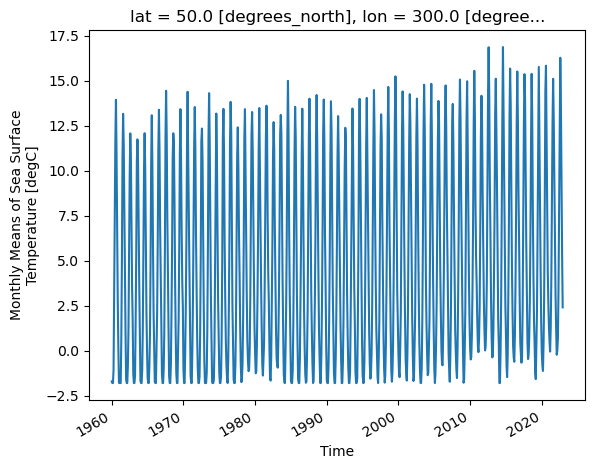
As we can see from the plot, the timeseries at any one point is totally dominated by the seasonal cycle. We would like to remove this seasonal cycle (called the “climatology”) in order to better see the long-term variaitions in temperature. We will accomplish this using groupby.
The syntax of Xarray’s groupby is almost identical to Pandas. We will first apply groupby to a single DataArray.
ds.sst.groupby?
Signature:
ds.sst.groupby(
group: 'Hashable | DataArray | IndexVariable',
squeeze: 'bool' = True,
restore_coord_dims: 'bool' = False,
) -> 'DataArrayGroupBy'
Docstring:
Returns a DataArrayGroupBy object for performing grouped operations.
Parameters
----------
group : Hashable, DataArray or IndexVariable
Array whose unique values should be used to group this array. If a
Hashable, must be the name of a coordinate contained in this dataarray.
squeeze : bool, default: True
If "group" is a dimension of any arrays in this dataset, `squeeze`
controls whether the subarrays have a dimension of length 1 along
that dimension or if the dimension is squeezed out.
restore_coord_dims : bool, default: False
If True, also restore the dimension order of multi-dimensional
coordinates.
Returns
-------
grouped : DataArrayGroupBy
A `DataArrayGroupBy` object patterned after `pandas.GroupBy` that can be
iterated over in the form of `(unique_value, grouped_array)` pairs.
Examples
--------
Calculate daily anomalies for daily data:
>>> da = xr.DataArray(
... np.linspace(0, 1826, num=1827),
... coords=[pd.date_range("2000-01-01", "2004-12-31", freq="D")],
... dims="time",
... )
>>> da
<xarray.DataArray (time: 1827)>
array([0.000e+00, 1.000e+00, 2.000e+00, ..., 1.824e+03, 1.825e+03,
1.826e+03])
Coordinates:
* time (time) datetime64[ns] 2000-01-01 2000-01-02 ... 2004-12-31
>>> da.groupby("time.dayofyear") - da.groupby("time.dayofyear").mean("time")
<xarray.DataArray (time: 1827)>
array([-730.8, -730.8, -730.8, ..., 730.2, 730.2, 730.5])
Coordinates:
* time (time) datetime64[ns] 2000-01-01 2000-01-02 ... 2004-12-31
dayofyear (time) int64 1 2 3 4 5 6 7 8 ... 359 360 361 362 363 364 365 366
See Also
--------
:ref:`groupby`
Users guide explanation of how to group and bin data.
DataArray.groupby_bins
Dataset.groupby
core.groupby.DataArrayGroupBy
pandas.DataFrame.groupby
File: /srv/conda/envs/notebook/lib/python3.11/site-packages/xarray/core/dataarray.py
Type: method
21.2.1. Split Step#
The most important argument is group: this defines the unique values we will use to “split” the data for grouped analysis. We can pass either a DataArray or a name of a variable in the dataset. Lets first use a DataArray. Just like with Pandas, we can use the time indexe to extract specific components of dates and times. Xarray uses a special syntax for this .dt, called the DatetimeAccessor.
See a list of datatime properties you can access through .dt here
ds.time.dt
<xarray.core.accessor_dt.DatetimeAccessor at 0x782654284490>
ds.time.dt.month
<xarray.DataArray 'month' (time: 756)>
array([ 1, 2, 3, ..., 10, 11, 12])
Coordinates:
* time (time) datetime64[ns] 1960-01-01 1960-02-01 ... 2022-12-01
Attributes:
long_name: Time
delta_t: 0000-01-00 00:00:00
avg_period: 0000-01-00 00:00:00
prev_avg_period: 0000-00-07 00:00:00
standard_name: time
axis: T
actual_range: [19723. 81722.]
_ChunkSizes: 1ds.time.dt.year
<xarray.DataArray 'year' (time: 756)>
array([1960, 1960, 1960, ..., 2022, 2022, 2022])
Coordinates:
* time (time) datetime64[ns] 1960-01-01 1960-02-01 ... 2022-12-01
Attributes:
long_name: Time
delta_t: 0000-01-00 00:00:00
avg_period: 0000-01-00 00:00:00
prev_avg_period: 0000-00-07 00:00:00
standard_name: time
axis: T
actual_range: [19723. 81722.]
_ChunkSizes: 1We can use these arrays in a groupby operation:
gb = ds.sst.groupby(ds.time.dt.month)
gb
DataArrayGroupBy, grouped over 'month'
12 groups with labels 1, 2, 3, 4, 5, 6, 7, 8, 9, 10, 11, 12.
Xarray also offers a more concise syntax when the variable you’re grouping on is already present in the dataset. This is identical to the previous line:
gb = ds.sst.groupby('time.month')
gb
DataArrayGroupBy, grouped over 'month'
12 groups with labels 1, 2, 3, 4, 5, 6, 7, 8, 9, 10, 11, 12.
Now that the data are split, we can manually iterate over the group. The iterator returns the key (group name) and the value (the actual dataset corresponding to that group) for each group.
for group_name, group_da in gb:
# stop iterating after the first loop
break
print(group_name)
group_da
1
<xarray.DataArray 'sst' (time: 63, lat: 89, lon: 180)>
[1009260 values with dtype=float32]
Coordinates:
* lat (lat) float32 88.0 86.0 84.0 82.0 80.0 ... -82.0 -84.0 -86.0 -88.0
* lon (lon) float32 0.0 2.0 4.0 6.0 8.0 ... 350.0 352.0 354.0 356.0 358.0
* time (time) datetime64[ns] 1960-01-01 1961-01-01 ... 2022-01-01
Attributes:
long_name: Monthly Means of Sea Surface Temperature
units: degC
var_desc: Sea Surface Temperature
level_desc: Surface
statistic: Mean
dataset: NOAA Extended Reconstructed SST V5
parent_stat: Individual Values
actual_range: [-1.8 42.32636]
valid_range: [-1.8 45. ]
_ChunkSizes: [ 1 89 180]21.2.2. Map & Combine#
Now that we have groups defined, it’s time to “apply” a calculation to the group. Like in Pandas, these calculations can either be:
aggregation: reduces the size of the group
transformation: preserves the group’s full size
At then end of the apply step, xarray will automatically combine the aggregated / transformed groups back into a single object.
Warning
Xarray calls the “apply” step map. This is different from Pandas!
The most fundamental way to apply is with the .map method.
gb.map?
Signature:
gb.map(
func: 'Callable[..., DataArray]',
args: 'tuple[Any, ...]' = (),
shortcut: 'bool | None' = None,
**kwargs: 'Any',
) -> 'DataArray'
Docstring:
Apply a function to each array in the group and concatenate them
together into a new array.
`func` is called like `func(ar, *args, **kwargs)` for each array `ar`
in this group.
Apply uses heuristics (like `pandas.GroupBy.apply`) to figure out how
to stack together the array. The rule is:
1. If the dimension along which the group coordinate is defined is
still in the first grouped array after applying `func`, then stack
over this dimension.
2. Otherwise, stack over the new dimension given by name of this
grouping (the argument to the `groupby` function).
Parameters
----------
func : callable
Callable to apply to each array.
shortcut : bool, optional
Whether or not to shortcut evaluation under the assumptions that:
(1) The action of `func` does not depend on any of the array
metadata (attributes or coordinates) but only on the data and
dimensions.
(2) The action of `func` creates arrays with homogeneous metadata,
that is, with the same dimensions and attributes.
If these conditions are satisfied `shortcut` provides significant
speedup. This should be the case for many common groupby operations
(e.g., applying numpy ufuncs).
*args : tuple, optional
Positional arguments passed to `func`.
**kwargs
Used to call `func(ar, **kwargs)` for each array `ar`.
Returns
-------
applied : DataArray
The result of splitting, applying and combining this array.
File: /srv/conda/envs/notebook/lib/python3.11/site-packages/xarray/core/groupby.py
Type: method
21.2.2.1. Aggregations#
Like Pandas, xarray’s groupby object has many built-in aggregation operations (e.g. mean, min, max, std, etc):
sst_mm = gb.mean(dim='time')
sst_mm
<xarray.DataArray 'sst' (month: 12, lat: 89, lon: 180)>
array([[[-1.8 , -1.8 , -1.8 , ..., -1.8 ,
-1.8 , -1.8 ],
[-1.8 , -1.8 , -1.8 , ..., -1.8 ,
-1.8 , -1.8 ],
[-1.8 , -1.8 , -1.8 , ..., -1.8 ,
-1.8 , -1.8 ],
...,
[ nan, nan, nan, ..., nan,
nan, nan],
[ nan, nan, nan, ..., nan,
nan, nan],
[ nan, nan, nan, ..., nan,
nan, nan]],
[[-1.8 , -1.8 , -1.8 , ..., -1.8 ,
-1.8 , -1.8 ],
[-1.8 , -1.8 , -1.8 , ..., -1.8 ,
-1.8 , -1.8 ],
[-1.8 , -1.8 , -1.8 , ..., -1.8 ,
-1.8 , -1.8 ],
...
[ nan, nan, nan, ..., nan,
nan, nan],
[ nan, nan, nan, ..., nan,
nan, nan],
[ nan, nan, nan, ..., nan,
nan, nan]],
[[-1.7995342, -1.7996206, -1.7998532, ..., -1.7998041,
-1.7996737, -1.7995361],
[-1.7995963, -1.799773 , -1.8 , ..., -1.8 ,
-1.7998328, -1.7996292],
[-1.8 , -1.8 , -1.8 , ..., -1.8 ,
-1.8 , -1.8 ],
...,
[ nan, nan, nan, ..., nan,
nan, nan],
[ nan, nan, nan, ..., nan,
nan, nan],
[ nan, nan, nan, ..., nan,
nan, nan]]], dtype=float32)
Coordinates:
* lat (lat) float32 88.0 86.0 84.0 82.0 80.0 ... -82.0 -84.0 -86.0 -88.0
* lon (lon) float32 0.0 2.0 4.0 6.0 8.0 ... 350.0 352.0 354.0 356.0 358.0
* month (month) int64 1 2 3 4 5 6 7 8 9 10 11 12
Attributes:
long_name: Monthly Means of Sea Surface Temperature
units: degC
var_desc: Sea Surface Temperature
level_desc: Surface
statistic: Mean
dataset: NOAA Extended Reconstructed SST V5
parent_stat: Individual Values
actual_range: [-1.8 42.32636]
valid_range: [-1.8 45. ]
_ChunkSizes: [ 1 89 180].map accepts as its argument a function. We can pass an existing function:
gb.map(np.mean)
<xarray.DataArray 'sst' (month: 12)>
array([13.67924 , 13.787482, 13.784192, 13.703959, 13.662183, 13.736521,
13.950218, 14.123172, 14.008661, 13.715476, 13.52839 , 13.548249],
dtype=float32)
Coordinates:
* month (month) int64 1 2 3 4 5 6 7 8 9 10 11 12Because we specified no extra arguments (like axis) the function was applied over all space and time dimensions. This is not what we wanted. Instead, we could define a custom function. This function takes a single argument–the group dataset–and returns a new dataset to be combined:
def time_mean(a):
return a.mean(dim='time')
sst_mm = gb.map(time_mean)
sst_mm
<xarray.DataArray 'sst' (month: 12, lat: 89, lon: 180)>
array([[[-1.800001 , -1.800001 , -1.800001 , ..., -1.800001 ,
-1.800001 , -1.800001 ],
[-1.800001 , -1.800001 , -1.800001 , ..., -1.800001 ,
-1.800001 , -1.800001 ],
[-1.800001 , -1.800001 , -1.800001 , ..., -1.800001 ,
-1.800001 , -1.800001 ],
...,
[ nan, nan, nan, ..., nan,
nan, nan],
[ nan, nan, nan, ..., nan,
nan, nan],
[ nan, nan, nan, ..., nan,
nan, nan]],
[[-1.800001 , -1.800001 , -1.800001 , ..., -1.800001 ,
-1.800001 , -1.800001 ],
[-1.800001 , -1.800001 , -1.800001 , ..., -1.800001 ,
-1.800001 , -1.800001 ],
[-1.800001 , -1.800001 , -1.800001 , ..., -1.800001 ,
-1.800001 , -1.800001 ],
...
[ nan, nan, nan, ..., nan,
nan, nan],
[ nan, nan, nan, ..., nan,
nan, nan],
[ nan, nan, nan, ..., nan,
nan, nan]],
[[-1.7995352, -1.7996216, -1.7998542, ..., -1.799805 ,
-1.7996746, -1.7995371],
[-1.7995974, -1.799774 , -1.800001 , ..., -1.800001 ,
-1.7998339, -1.7996302],
[-1.800001 , -1.800001 , -1.800001 , ..., -1.800001 ,
-1.800001 , -1.800001 ],
...,
[ nan, nan, nan, ..., nan,
nan, nan],
[ nan, nan, nan, ..., nan,
nan, nan],
[ nan, nan, nan, ..., nan,
nan, nan]]], dtype=float32)
Coordinates:
* lat (lat) float32 88.0 86.0 84.0 82.0 80.0 ... -82.0 -84.0 -86.0 -88.0
* lon (lon) float32 0.0 2.0 4.0 6.0 8.0 ... 350.0 352.0 354.0 356.0 358.0
* month (month) int64 1 2 3 4 5 6 7 8 9 10 11 12So we did what we wanted to do: calculate the climatology at every point in the dataset. Let’s look at the data a bit.
Climatlogy at a specific point in the North Atlantic
sst_mm.sel(lon=300, lat=-50).plot()
[<matplotlib.lines.Line2D at 0x78264c002c10>]

Zonal Mean Climatology
sst_mm.mean(dim='lon').transpose().plot.contourf(levels=12, vmin=-2, vmax=30)
<matplotlib.contour.QuadContourSet at 0x78264bee8910>
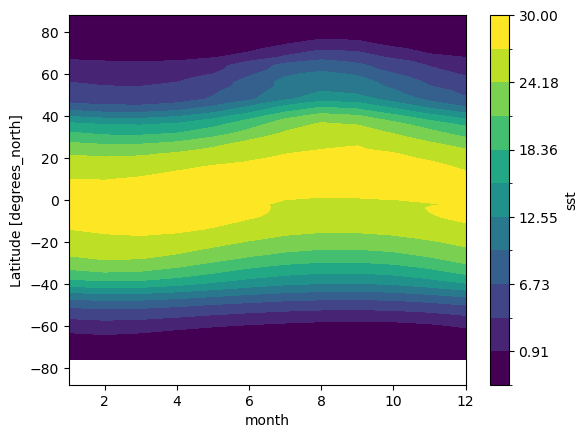
Difference between January and July Climatology
(sst_mm.sel(month=1) - sst_mm.sel(month=7)).plot(vmax=10)
<matplotlib.collections.QuadMesh at 0x78264bf24690>
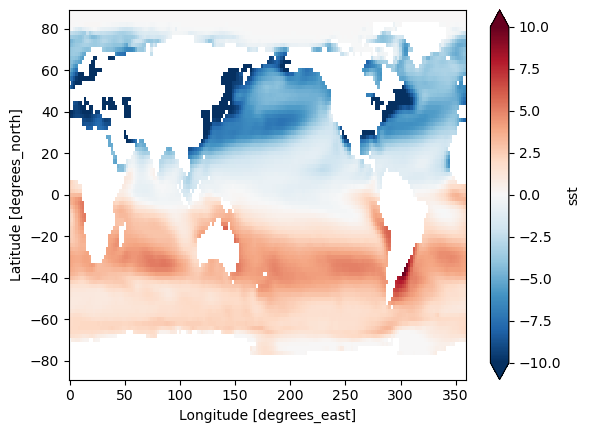
21.2.2.2. Transformations#
Now we want to remove this climatology from the dataset, to examine the residual, called the anomaly, which is the interesting part from a climate perspective. Removing the seasonal climatology is a perfect example of a transformation: it operates over a group, but doesn’t change the size of the dataset. Here is one way to code it.
def remove_time_mean(x):
return x - x.mean(dim='time')
ds_anom = ds.groupby('time.month').map(remove_time_mean)
ds_anom
<xarray.Dataset>
Dimensions: (lat: 89, lon: 180, time: 756)
Coordinates:
* lat (lat) float32 88.0 86.0 84.0 82.0 80.0 ... -82.0 -84.0 -86.0 -88.0
* lon (lon) float32 0.0 2.0 4.0 6.0 8.0 ... 350.0 352.0 354.0 356.0 358.0
* time (time) datetime64[ns] 1960-01-01 1960-02-01 ... 2022-12-01
Data variables:
sst (time, lat, lon) float32 1.073e-06 1.073e-06 1.073e-06 ... nan nanNote
In the above example, we applied groupby to a Dataset instead of a DataArray.
Xarray makes these sorts of transformations easy by supporting groupby arithmetic. This concept is easiest explained with an example:
gb = ds.groupby('time.month')
ds_anom = gb - gb.mean(dim='time')
ds_anom
<xarray.Dataset>
Dimensions: (lat: 89, lon: 180, time: 756)
Coordinates:
* lat (lat) float32 88.0 86.0 84.0 82.0 80.0 ... -82.0 -84.0 -86.0 -88.0
* lon (lon) float32 0.0 2.0 4.0 6.0 8.0 ... 350.0 352.0 354.0 356.0 358.0
* time (time) datetime64[ns] 1960-01-01 1960-02-01 ... 2022-12-01
month (time) int64 1 2 3 4 5 6 7 8 9 10 11 ... 2 3 4 5 6 7 8 9 10 11 12
Data variables:
sst (time, lat, lon) float32 0.0 0.0 0.0 0.0 0.0 ... nan nan nan nanNow we can view the climate signal without the overwhelming influence of the seasonal cycle.
Timeseries at a single point in the North Atlantic
ds_anom.sst.sel(lon=300, lat=50).plot()
[<matplotlib.lines.Line2D at 0x78264be4f090>]

Difference between Jan. 1 2018 and Jan. 1 1960
(ds_anom.sel(time='2022-01-01') - ds_anom.sel(time='1960-01-01')).sst.plot()
<matplotlib.collections.QuadMesh at 0x78264bcc95d0>
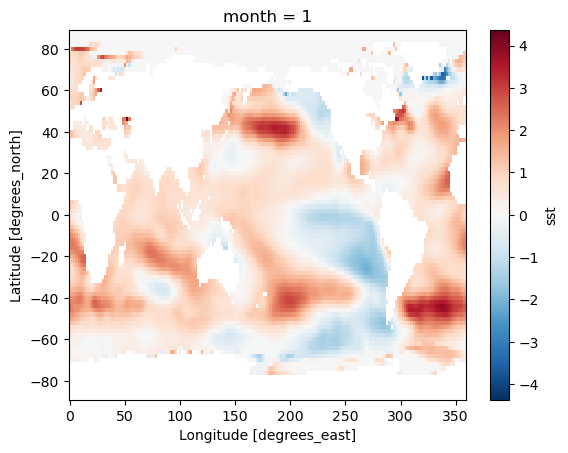
21.4. Coarsen#
coarsen is a simple way to reduce the size of your data along one or more axes.
It is very similar to resample when operating on time dimensions; the key difference is that coarsen only operates on fixed blocks of data, irrespective of the coordinate values, while resample actually looks at the coordinates to figure out, e.g. what month a particular data point is in.
For regularly-spaced monthly data beginning in January, the following should be equivalent to annual resampling. However, results would different for irregularly-spaced data.
ds.coarsen(time=12,boundary = 'exact').mean()
<xarray.Dataset>
Dimensions: (time: 63, lat: 89, lon: 180)
Coordinates:
* lat (lat) float32 88.0 86.0 84.0 82.0 80.0 ... -82.0 -84.0 -86.0 -88.0
* lon (lon) float32 0.0 2.0 4.0 6.0 8.0 ... 350.0 352.0 354.0 356.0 358.0
* time (time) datetime64[ns] 1960-06-16T08:00:00 ... 2022-06-16T12:00:00
Data variables:
sst (time, lat, lon) float32 -1.8 -1.8 -1.8 -1.8 ... nan nan nan nan
Attributes: (12/39)
climatology: Climatology is based on 1971-2000 SST, X...
description: In situ data: ICOADS2.5 before 2007 and ...
keywords_vocabulary: NASA Global Change Master Directory (GCM...
keywords: Earth Science > Oceans > Ocean Temperatu...
instrument: Conventional thermometers
source_comment: SSTs were observed by conventional therm...
... ...
comment: SSTs were observed by conventional therm...
summary: ERSST.v5 is developed based on v4 after ...
dataset_title: NOAA Extended Reconstructed SST V5
_NCProperties: version=2,netcdf=4.6.3,hdf5=1.10.5
data_modified: 2023-11-03
DODS_EXTRA.Unlimited_Dimension: timeCoarsen also works on spatial coordinates (or any coordiantes).
ds_coarse = ds.coarsen(lon=4, lat=4, boundary='pad').mean()
ds_coarse.sst.isel(time=0).plot(vmin=2, vmax=30, figsize=(12, 5), edgecolor='k')
<matplotlib.collections.QuadMesh at 0x78264b9d15d0>
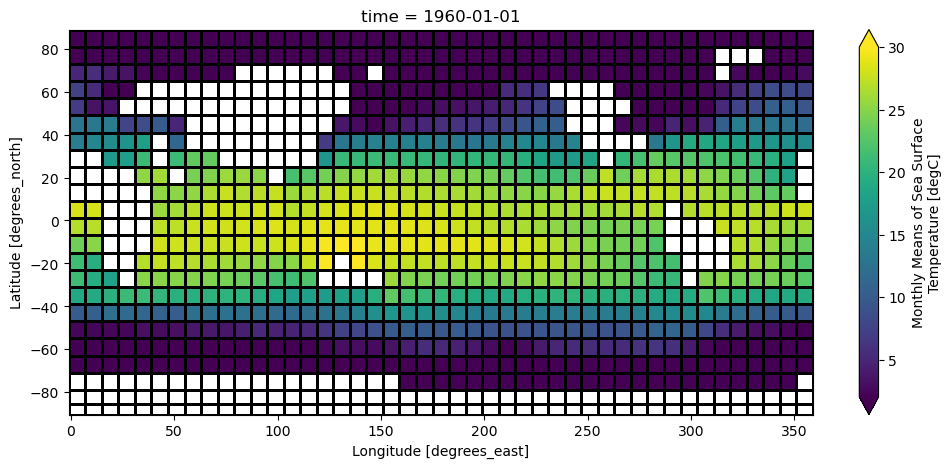
21.5. An Advanced Example#
In this example we will show a realistic workflow with Xarray. We will
Load a “basin mask” dataset
Interpolate the basins to our SST dataset coordinates
Group the SST by basin
Convert to Pandas Dataframe and plot mean SST by basin
basin = xr.open_dataset('http://iridl.ldeo.columbia.edu/SOURCES/.NOAA/.NODC/.WOA09/.Masks/.basin/dods')
basin
<xarray.Dataset>
Dimensions: (Y: 180, Z: 33, X: 360)
Coordinates:
* Y (Y) float32 -89.5 -88.5 -87.5 -86.5 -85.5 ... 86.5 87.5 88.5 89.5
* Z (Z) float32 0.0 10.0 20.0 30.0 50.0 ... 4e+03 4.5e+03 5e+03 5.5e+03
* X (X) float32 0.5 1.5 2.5 3.5 4.5 ... 355.5 356.5 357.5 358.5 359.5
Data variables:
basin (Z, Y, X) float32 ...
Attributes:
Conventions: IRIDLbasin = basin.rename({'X': 'lon', 'Y': 'lat'})
basin
<xarray.Dataset>
Dimensions: (lat: 180, Z: 33, lon: 360)
Coordinates:
* lat (lat) float32 -89.5 -88.5 -87.5 -86.5 -85.5 ... 86.5 87.5 88.5 89.5
* Z (Z) float32 0.0 10.0 20.0 30.0 50.0 ... 4e+03 4.5e+03 5e+03 5.5e+03
* lon (lon) float32 0.5 1.5 2.5 3.5 4.5 ... 355.5 356.5 357.5 358.5 359.5
Data variables:
basin (Z, lat, lon) float32 ...
Attributes:
Conventions: IRIDLbasin_surf = basin.basin[0]
basin_surf
<xarray.DataArray 'basin' (lat: 180, lon: 360)>
[64800 values with dtype=float32]
Coordinates:
* lat (lat) float32 -89.5 -88.5 -87.5 -86.5 -85.5 ... 86.5 87.5 88.5 89.5
Z float32 0.0
* lon (lon) float32 0.5 1.5 2.5 3.5 4.5 ... 355.5 356.5 357.5 358.5 359.5
Attributes:
long_name: basin code
units: ids
scale_max: 58
CLIST: Atlantic Ocean\nPacific Ocean \nIndian Ocean\nMediterranean S...
valid_min: 1
valid_max: 58
scale_min: 1basin_surf.plot(vmax=10)
#basin_surf
<matplotlib.collections.QuadMesh at 0x78264ba04610>
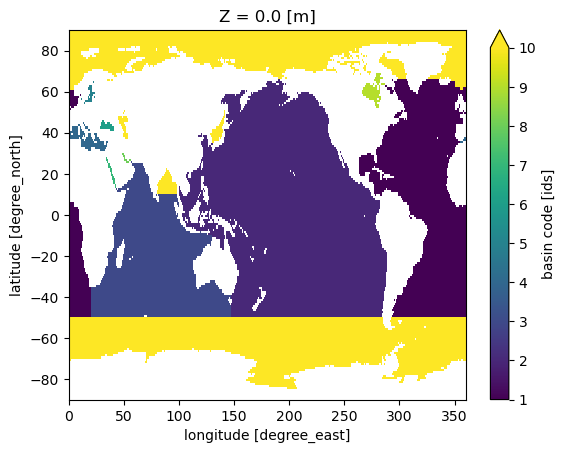
basin_surf_interp = basin_surf.interp_like(ds.sst, method='nearest')
basin_surf_interp.plot(vmax=10)
#basin_surf_interp
<matplotlib.collections.QuadMesh at 0x78264afdfe50>

ds.sst.groupby(basin_surf_interp).first()
<__array_function__ internals>:200: RuntimeWarning: invalid value encountered in cast
<xarray.DataArray 'sst' (time: 756, basin: 14)>
array([[-1.8 , -1.8 , 23.455315 , ..., -1.8 ,
3.3971915 , 24.182198 ],
[-1.8 , -1.8 , 23.722523 , ..., -1.8 ,
0.03573781, 24.59657 ],
[-1.8 , -1.8 , 24.601315 , ..., -1.8 ,
-0.26487017, 26.234186 ],
...,
[ 0.89445347, 4.685296 , 29.049557 , ..., 8.882076 ,
16.515127 , 29.450462 ],
[-0.31460398, 1.8985674 , 27.785666 , ..., 3.4794273 ,
11.925127 , 27.901617 ],
[-1.8 , -0.24241269, 26.120224 , ..., 1.3552847 ,
7.9607453 , 25.901285 ]], dtype=float32)
Coordinates:
* time (time) datetime64[ns] 1960-01-01 1960-02-01 ... 2022-12-01
* basin (basin) float32 1.0 2.0 3.0 4.0 5.0 ... 10.0 11.0 12.0 53.0 56.0
Attributes:
long_name: Monthly Means of Sea Surface Temperature
units: degC
var_desc: Sea Surface Temperature
level_desc: Surface
statistic: Mean
dataset: NOAA Extended Reconstructed SST V5
parent_stat: Individual Values
actual_range: [-1.8 42.32636]
valid_range: [-1.8 45. ]
_ChunkSizes: [ 1 89 180]basin_mean_sst = ds.sst.groupby(basin_surf_interp).mean()
basin_mean_sst
<__array_function__ internals>:200: RuntimeWarning: invalid value encountered in cast
<xarray.DataArray 'sst' (time: 756, basin: 14)>
array([[18.585499 , 20.75755 , 21.572077 , ..., 6.238062 , 6.889794 ,
26.499819 ],
[18.705072 , 20.816761 , 21.902283 , ..., 4.8877654, 5.44638 ,
26.57709 ],
[18.845848 , 20.865032 , 22.031416 , ..., 4.686406 , 5.5322194,
27.90856 ],
...,
[20.133 , 21.700815 , 20.31083 , ..., 17.463427 , 18.683998 ,
29.5153 ],
[19.80138 , 21.430943 , 20.964071 , ..., 13.358289 , 14.617571 ,
28.847633 ],
[19.636013 , 21.297836 , 21.741606 , ..., 10.26373 , 11.0815325,
27.899845 ]], dtype=float32)
Coordinates:
* time (time) datetime64[ns] 1960-01-01 1960-02-01 ... 2022-12-01
Z float32 0.0
* basin (basin) float32 1.0 2.0 3.0 4.0 5.0 ... 10.0 11.0 12.0 53.0 56.0
Attributes:
long_name: Monthly Means of Sea Surface Temperature
units: degC
var_desc: Sea Surface Temperature
level_desc: Surface
statistic: Mean
dataset: NOAA Extended Reconstructed SST V5
parent_stat: Individual Values
actual_range: [-1.8 42.32636]
valid_range: [-1.8 45. ]
_ChunkSizes: [ 1 89 180]df = basin_mean_sst.mean('time').to_dataframe()
df
| Z | sst | |
|---|---|---|
| basin | ||
| 1.0 | 0.0 | 19.317692 |
| 2.0 | 0.0 | 21.204735 |
| 3.0 | 0.0 | 21.147755 |
| 4.0 | 0.0 | 19.902565 |
| 5.0 | 0.0 | 8.199746 |
| 6.0 | 0.0 | 15.138650 |
| 7.0 | 0.0 | 28.522148 |
| 8.0 | 0.0 | 26.654783 |
| 9.0 | 0.0 | 0.345633 |
| 10.0 | 0.0 | 1.550839 |
| 11.0 | 0.0 | -0.799598 |
| 12.0 | 0.0 | 12.162644 |
| 53.0 | 0.0 | 14.433341 |
| 56.0 | 0.0 | 28.495367 |
import pandas as pd
basin_names = basin_surf.attrs['CLIST'].split('\n')
basin_df = pd.Series(basin_names, index=np.arange(1, len(basin_names)+1))
basin_df
1 Atlantic Ocean
2 Pacific Ocean
3 Indian Ocean
4 Mediterranean Sea
5 Baltic Sea
6 Black Sea
7 Red Sea
8 Persian Gulf
9 Hudson Bay
10 Southern Ocean
11 Arctic Ocean
12 Sea of Japan
13 Kara Sea
14 Sulu Sea
15 Baffin Bay
16 East Mediterranean
17 West Mediterranean
18 Sea of Okhotsk
19 Banda Sea
20 Caribbean Sea
21 Andaman Basin
22 North Caribbean
23 Gulf of Mexico
24 Beaufort Sea
25 South China Sea
26 Barents Sea
27 Celebes Sea
28 Aleutian Basin
29 Fiji Basin
30 North American Basin
31 West European Basin
32 Southeast Indian Basin
33 Coral Sea
34 East Indian Basin
35 Central Indian Basin
36 Southwest Atlantic Basin
37 Southeast Atlantic Basin
38 Southeast Pacific Basin
39 Guatemala Basin
40 East Caroline Basin
41 Marianas Basin
42 Philippine Sea
43 Arabian Sea
44 Chile Basin
45 Somali Basin
46 Mascarene Basin
47 Crozet Basin
48 Guinea Basin
49 Brazil Basin
50 Argentine Basin
51 Tasman Sea
52 Atlantic Indian Basin
53 Caspian Sea
54 Sulu Sea II
55 Venezuela Basin
56 Bay of Bengal
57 Java Sea
58 East Indian Atlantic Basin
dtype: object
df = df.join(basin_df.rename('basin_name'))
df.plot.bar(y='sst', x='basin_name')
<Axes: xlabel='basin_name'>


